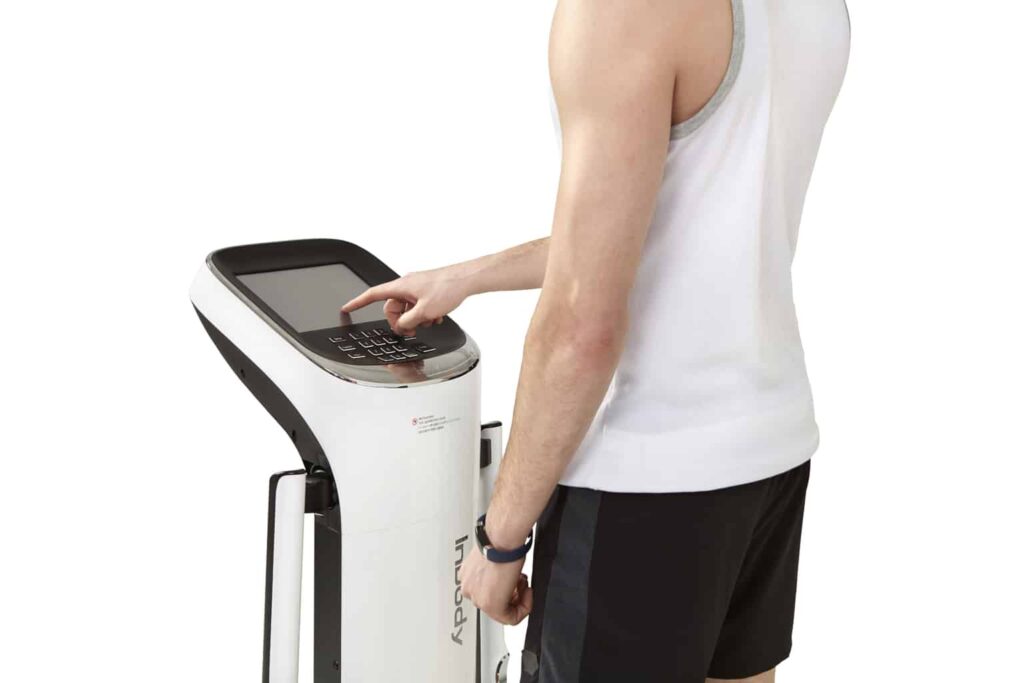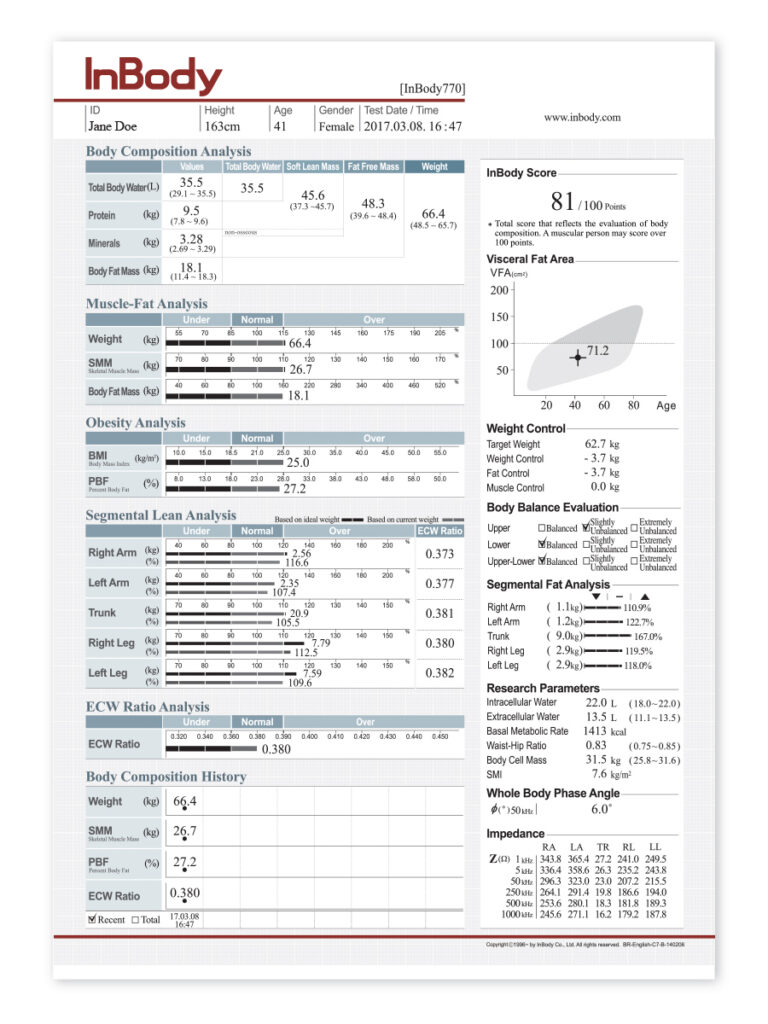InBody 970 body analysis
Body composition
Get a unique insight into your inner health how water, minerals, muscle and fat are distributed. Our advanced InBody 970 also measures your cell health (phase angle) and it shows water both inside the cells (ICW) and outside the cells (ECW) and tells you how much of your fat is the visceral (dangerous) fat.
The weight is not relevant if you do not know what it consists of. Doing a body composition analysis, or body scan, where you measure the exact relationships between muscle, skeleton, fat and fluid is a prerequisite for understanding the relationship between health, food and exercise. A body analysis with Inbody 970 can be compared to a DEXA X-ray and is the first of its kind NOT to use pre-programmed empirical data such as age, gender or if you have a standard or athletic physique. You get to know exactly how your body is built inside. You get a comprehensive analysis of your state of health and status of how muscles, fat and fluid are distributed in the legs, arms and torso and in what balance they are.
This is how it works
The Inbody 970 is the market’s most accurate multi-frequency bioimpedance meter. It gives you answers to your composition of, among other things, muscle, fat, minerals, water at the cellular level and bone density. InBody 970 uses 8 polar tactile electrodes through which a weak electric current is sent through the body. The resistance from the impulses in the different tissues and fluids is measured and you get a direct answer to your unique composition in 5 different impedance readings for the body’s torso and four extremities. This exclusive in-depth InBody analysis provides accurate results for total body composition.
Inbody 970 body composition analyzer is used in i.a. rehabilitation, sports medicine and neurology. Inbody is today the market’s only bioimpedance meter that does not use empirical data for results. Therefore, elite sports, the Swedish Olympic Committee, the university hospitals and the research world have been able to approve it in their activities. Inbody is equipped with technology that achieves high reliability in correlation with DEXA, the golden standard for body composition analysis.
Your first measurement takes about 30 minutes, including a thorough review of your result. InBody is a bio-impedance meter that has eight measuring points. The measuring process is simple as you stand barefoot on a platform while holding two handles. InBody does not use empirical data that affects test results. Therefore, InBody is used in research and elite sports and has a comparability to DEXA X-rays of 98%.
What does the analysis give you
An InBody analysis helps you to set up a strategy towards your specific goals. You get a basis for creating an exercise program that is based on facts about your body. InBody simplifies training follow-up and the result becomes clearer. It is interesting to see the current situation inside the body in numbers. Being able to follow up your investment and see the change in body composition is very motivating.
The InBody body composition measurement provides an objective picture of the body. The InBody measurement is helpful in the follow-up of health and exercise, eating habits, weight control and in other life changes.
The measurement is made so that you stand barefoot on the device and hold the handles for a few minutes.
The measurement should be made on an empty stomach, preferably at least two hours after the meal.
Visit the toilet before the measurement.
No sports, sauna or shower before the measurement.
Stand up for at least 5 minutes before the measurement.
To get the right weight, dress in thin clothes, preferably only panties / underpants.
Follow-up measurements should be made under similar conditions as previous measurements.
Measurements can not be made if you are pregnant, have a pace-maker or have an amputated leg / foot or an amputated arm / hand.
Measurement can be done on people from 3 years and up, but assumes that you are able to stand up and hold two handles and stand completely still and not talk for about a minute.
The measurement result can be misleading if you take diuretics or have metal implants.
Personal information (ID) – gender, age, weight, height and date of testing.
2. Composition of the body (Kehon koostumus) – Contains precise information about the composition of the body. Body fluids: ICW (intracellular) indicates the total amount of fluid inside the cells and ECW (extracellular) indicates the amount of fluid outside the cells. ICW and ECW together make up the total amount of fluid in the body. The fluid outside the cells (ECW) tells you about your fluid balance. If too much fluid accumulates outside the cells, it causes swelling (edema). Amount of protein: Proteins are the main building material of muscles and skin. Minerals: minerals are found both in the skeleton (about 80%) and in the body’s fluids (about 20% of the total mineral mass). The value indicates the total amount of minerals in kg and the total skeletal mass (= osseous). The amount of mineral can not be measured directly with this analysis, but is only estimated on the basis of the other values. Amount of fat: the total amount of fat, including subcutaneous fat, fat between the organs and fat in the muscles. Total amount of mass: mass without fat + mass with fat. Viitearvo = reference value or normal value for a person of the same sex and the same length.
Muscle-fat balance (Lihas-Rasvadiagnoosi) – the analysis compares the relationship between total weight, muscle weight and fat weight. The bar indicates the weight ratio compared to an equal person’s reference value (100%). The value in front of the line indicates your actual weight and the amount of muscle and fat. From these values, you can read what makes up the majority of your weight. Ideally, if the bars form a D, ie. that the relative proportion of muscle mass is large and the amount of fat is small. Diet and exercise have a positive effect on muscle mass (more) and the amount of fat negatively (less).
4. Weight analysis – The analysis has collected the most common values in weight control: weight index (kg / m2, normal value 18.5-25.0), fat percentage (normal value: men <20% and women <28%) and waist-hip relationship . NOTE! The waist-hip relationship is appreciated. If the weight index exceeds the normal value and the amount of muscle is abundant, no weight loss is needed!
5. Muscle balance – The top line indicates muscle mass (kg) compared to an equal person’s reference value, the middle line indicates the body part’s muscle mass in% compared to an equal person’s reference value and the bottom dotted line shows muscle mass (%) compared to your own weight. The bottom line has no real meaning, so we can ignore it.
6. Visceral Fat – Indicates the amount of fat in the abdomen around the internal organs. The value is presented in square centimeters (cm2) and measured at the waist. Recommended value regardless of age is below 100 cm2. This is an important value in terms of health and a value above 100 indicates increased health risks. Especially the risk of diabetes and cardiovascular disease increases sharply.
7. Fluid index – The index on the left indicates the relationship between the fluid outside the cells and the body’s total fluid volume (ECF / TBF) and the normal value is 0.31-0.35. The index on the right (ECW / TBW), whose normal value is 0.36-0.40, indicates the body’s amount of fluid in relation to body weight. With this value you can see if there is accumulated extra fluid in any part of the body (segmental fluid index). An abnormal fluid balance can be due to e.g. the following things; medication, heart failure or other illness, if you have been sitting or standing for a long time in the same position, sauna bath, if you have eaten close to the test, menstrual period, pregnancy or heavy exercise. Other causes can be malnutrition in the elderly or sarcopenia, ie. muscle wasting in the elderly. People with high obesity usually also get a higher fluid index due to. that there is less fluid inside fat cells than in other cells.
8. General values, summary – The general values in the right margin (nutritional evaluation, weight control, weight analysis, etc.) show a general evaluation of the body’s composition. You get a quick overview of the different sub-areas whether they are normal or not.
9. Weight control – Shows how much you would need to increase / decrease in weight or muscle mass. This can motivate you and is a good benchmark for exercisers. If you are 0-5 kg from your ideal weight, you can count on having a normal weight. The ideal weight is calculated for men with a fat percentage of 15% and for women with a fat percentage of 23%. Your desired weight is thus your current weight +/- weight control and the weight control is fat control + muscle control. Fitness index – The result is almost an index that you can follow if you measure several times, a higher value is better. It does not make sense to compare yourself with others. Guideline values for this index are that below 70 indicates thinness or obesity, an index of 70-90 is normal and a value above 90 indicates that you are strong / muscular.
10. Impedance – InBody 970 measures body composition with impedance (electrical resistance) and with 8 different frequencies to get the most reliable result possible.
11. Body Compassion History – The device has the ability to p
Blood pressure measurement, heart rate and blood oxygen saturation
If you have or have had high or low blood pressure, it may be a good idea to measure your blood pressure regularly. Even if you think you are in good health, it may be wise to test your blood pressure from time to time. This is to detect any diseases or ill health in good time. If you have high blood pressure, this is an indication that the heart has to work extra hard to compensate for something.
High blood pressure is usually due to poor health or illness. Most often it is because one or more blood vessels are clogged due to an unhealthy lifestyle. The risk of walking around with high blood pressure is that you are in the risk zone for suffering from cardiovascular disease. In the worst case, it can lead to a heart attack with a fatal outcome if not detected or treated in time.
An elevated blood pressure can sometimes cause symptoms such as headaches and swelling, but most often you do not know that you have too high blood pressure before testing it.
Some individuals may genetically have a slightly elevated blood pressure, but then it is usually stable above the normal value and is then classified as “normal” for that person. Too low blood pressure is usually genetic but can also be due to illness, anemia or malnutrition.
To determine that you have too high or too low blood pressure, you need to make 3 independent measurements with a certain time interval.
Blood pressure measurement
Things to keep in mind: Sit down for at least 10 minutes before the measurement and try to get down in laps. If you come directly from an exercise, you can have high blood pressure for natural and healthy reasons. Then the measurement becomes misleading. Avoid food and drink with caffeine two hours before the measurement. Also, try to avoid nicotine such as cigarettes and snus. Tell your if you have slept badly the night before or if you have an illness (or cold) at the time of the measurement.
Oxygen saturation
To get as safe a value as possible, it is good to think about this:
Warm your fingers if they are cold.
Do not use nail polish or loose nails.
Be still during the measurement, avoid strong or violent movements.
Do not be in bright light when making the measurement.
Pulse
In connection with blood pressure measurement and control of the blood’s oxygen saturation, we also take your resting heart rate.
Your heart rate says more than you might think. Having a high heart rate at rest can be a sign that you are ill or about to become pregnant, for example. But what exactly is resting heart rate and maximum heart rate? We explain the difference.
Yes, what is resting heart rate? The resting heart rate is the heart rate you have when you are completely relaxed. The best way to measure your resting heart rate is in the morning when you are calm, before caffeine or work takes over your body and mind. If your resting heart rate is 60, it means that your heart is pumping 60 beats per minute. A lower resting heart rate is a sign that the heart is more efficient, which is common in well-trained people. Gunde Svan is said to have had a resting heart rate of 32 during his skiing career, for example.
How do I measure my resting heart rate? There are several ways. The easiest way is to take your heart rate in the morning, shortly after you wake up, or if you have rested for 10-15 minutes. To be able to compare heart rate from time to time, it is important that you measure your heart rate at approximately the same time at each time. It is suggested to start when you have just woken up. Place your index and middle fingers against your wrist or on the side of your neck to measure your heart rate. Take a minute and count your heartbeats. A normal resting heart rate is usually about 60-80 beats per minute, but it is quite individual.
Okay, but what is the maximum heart rate? The maximum heart rate achieved during exertion is called the maximum heart rate. This maximum number of beats that your heart can beat is also individual and to some extent genetic. Unlike resting heart rate, maximum heart rate does not say much about whether you are fit or not. In general, the maximum heart rate also decreases with age.
How do I measure my maximum heart rate? Achieving maximum heart rate through exercise is, as you have already calculated, much more strenuous than taking a resting heart rate. The best is, for example, a maximum heart rate test, with really hard intervals on slopes or longer slopes. You need to be both rested and warmed up for a maximum heart rate test, so you can get out. Because it’s hard to get up to maximum heart rate. Run a number of intervals until you do not have the strength to take another step: then it is time to lie down, put your fingertips against your wrist and count your maximum heart rate. For a more approximate estimate of maximum heart rate, the calculation 220 minus your age is a decent indicator of where you are.
Values for a healthy and normal blood pressure
Systolic pressure, ie blood pressure when the heart contracts and pumps out the blood, should be between 100-140 mmHg.
Diastolic pressure, ie blood pressure when the heart dilates and fills with blood, should be between 60-90 mmHg.
An example of a normal blood pressure is thus 122/80. An example of high blood pressure is 166/105.
mmHg is the abbreviation for millimeters of mercury.
The pulse in adults and in children
An adult who rests usually has a heart rate of between 60 and 70 regular beats per minute. A well-trained person often has a lower resting heart rate, between 45 to 55 beats per minute or even lower.
In children under one year, the heart rate can be up to 160 beats per minute. Up to the age of ten, a child’s heart usually beats up to 110 beats per minute at rest. Children over the age of ten usually have a heart rate of 60 to 80 beats per minute.
The body needs oxygen to function
The air you breathe into your lungs contains oxygen that your body needs. The blood then transports oxygen from the lungs to the body’s cells and tissues. How much oxygen you have in your blood is stated in percent.
The value of a healthy person should be between 95 and 100 percent.
A young healthy individual has about 97% oxygen saturation (oxygen saturation) in the blood but the value decreases with age. Values below 90% have a long-term detrimental effect on the body and values below 70% are potentially life-threatening.
Sometimes oxygen is given at low oxygenation, but too high an oxygen content in the inhaled air and the tissues can also be harmful. There is almost never any reason to raise oxygen saturation above normal for age.


When weighing, you get up to 7 different result sheets.


